This is the story of how I, Skipper
Herco and crew Dirk sailed the 14 ft dinghy Kurkprop across Delagoa
Bay.
I have never in my life spent so much time on researching and
planning a holiday as on this one. What was supposed to be a romantic
second honeymoon, dinghy cruising from hotel to hotel with a night
of sleeping on board under the tropical stars of southern Mozambique,
turned out to be a fully-fledged extended family cross-border
holiday! Three generations of the family went along; there were
nine of us in all! Plans where changed and changed again and then
yet again. The plans changed so much, in fact, that the reason
for going - sailing Kurkprop, my home-built 14 ft gaff sloop dinghy
on the ocean - almost didn't happen at all! The circle was almost
complete; from fantasising about what it would be like to sail
on the ocean, watching the land gradually fade away, to actually
doing it took four long years. At last the time arrived and my
preparations were complete. All that needed to be done was to
hook up the boat and trailer, head off to Maputo and sail away
across Delagoa Bay. If I could just get the universe to give me
a break! (In fact the whole plan was a little like a stagger-drunk
sailor at the edge of a pier at spring low, right from the word
go.) The last straw was when Lucky stripped the wheel studs right
off the trailer, twelve hours before departure. "Leftie loosie;
righty tighty". I so wish someone had shown this to him earlier.
The weather was looking dodgy anyway. For four days it blew well
above average, so the thought crossed our minds: "Leave the
boat?". Luckily the universe gave me the best brothers in
the world. They saved the day and Kurkprop, after all, formed
part of the procession that slowly made its way to Maputo.
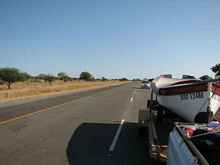 |
They saved the day and Kurkprop, after all,
formed part of the procession that slowly made its way to
Maputo. |
There we were at the Mozambique-South Africa border, twenty four
hours behind schedule, but at last the holiday feeling was beginning
to wash over us. The border was a breeze, with everyone being
so friendly and helpful. And it looked as though Maputo had picked
itself up a bit since last I was there ten years ago. All the
horror stories we had heard about seemed to be so untrue. "Just
leave your first world attitude at home" we thought, just
like the brochure put it. With the ferry to Inhaca leaving the
next day there was almost no unpacking. As soon as we had settled
in at Fatima’s Backpackers, we were off to rig and launch
Kurkprop without any further delay. Suddenly I longed for those
extra bad weather days that had been cut out of the plan as the
expedition planning progressed. The four days of hugging the bay
had been discarded for a 20 nm dash straight across to Inhaca
Island. The state of the sea was terrible, with really huge swells.
I knew at once that I couldn't leave my two year old, the “apple
of my eye" alone overnight at this stage. The trauma left
by the death of her best friend, Grandpa, and then, two months
later, her mother, was still very evident and settling into the
vacation spirit was proving to be a little difficult for her.
Thus Kurkprop was left behind in Maputo. “Better safe than
sorry”. So near and yet so far; but not out yet! I was determined
to sail on the ocean, even if only for an hour.
Early the next morning, as we boarded the ferry, the weather looked
perfect for a crossing. The sun was glowing gold in the bay with
just enough breeze to make the water shimmer. Two hours later
and halfway across the bay I was glad that I had stuck to my guns,
heeded the weather forecast and gone on the ferry. The wind was
blowing force four with huge white-capped swells. A few of the
passengers hung over the side to “inspect the paintjob”
on the new ferry. By the time all the passenger and luggage had
been safely ferried to land by a swarm of small boats, everybody
began to look a lot better and after the first "coconut boom
boom" we started to catch the island vibe. Shoes where kicked
off to go exploring on the wide open sand flats that lie between
Inhaca and Portuguese Island, four kilometres to the north west.
 |
Exploring the Low tide sand flats |
There were thousands of small fish, hundreds of crabs; even
a big beautiful bright red star fish! Walking back in the ankle
deep water of the rising tide, we could understand why it is said
to be unwise to walk to Portuguese Island. The high tide will
get you first! Our first day in paradise ended happy and beautiful
as the sun sunk over the bay, with two nieces running naked in
the warm shallow water, wavelets lapping at their ankles. Now
I understood about the magical sunsets on Inhaca. Everything was
absolutely perfect, except for one thing...
We were missing a boat. Being herded like cattle onto a very dodgy
RIB for a day trip to Portuguese Island that ends two hours earlier
than advertised wasn’t for us at all! The island life is
pleasant, but you want to be out on the water, so that you can
reach the light house, Portuguese Island, and the coral gardens
in your own good time. And then there are still so many other
dreams to dream. Either you need your own boat or you need lots
of money. Like all the islands in this area, Inhaca tends to be
a bit on the expensive side. The pressure was mounting from all
sides, so we decided to give sailing across Algoa Bay one more
try. The children were settled, the weather was calm. All we had
to do was to go to Maputo and sail back to Inhaca.
 |
Portugese isalnd in the distance. |
Mark, the Camp Master of Manico Camp, where we stayed, was bought
a beer and prodded for as much information about flights, ferry
times and navigational certificates as possible. Luckily the navigational
certificate could be organised from the local port captain and
before you could say "cheeseburger" our gear was in
bags and we were heading for Maputo. In perfect weather for a
crossing we motored over on a huge catamaran that looked so though
it could have sailed at one stage and then was converted for ferrying
partygoers to Inhaca. That evening my trusty crew and brother,
Dirk, and I were dinning on prawns at the waterfront bar and planning
our trip back to Inhaca. The next morning we were up at dawn and
since our lift had abandoned us, we had to drive the length and
breadth of Maputo to get the boat in the water and the bakkie
and trailer back to safe parking, all the while realising that
we were wasting much prime sailing time. The plan was to be on
Inhaca before the wind picked up at midday. The forecast called
for more than sitting back and soaking up the sunshine. Back at
the Maputo Marina we practised reefing a few times, checked that
the Seagull started and motored round the mole and into the gentle
swell running up the river. We gained some an idea of the speed
and fuel consumption of the Seagull, before hoisting Kurkprop’s
sails. I was the happiest man alive! I had set out to do something
that a lot of people thought was crazy, and, finally, I was getting
it right!
 |
Seagull |
On a long close-haul port tack we could aim almost straight
for home in the northern part of Inhaca, but calculated that,
with leeway, we should rather make landfall more to the middle
of the island and then tack up when we were in the lee of Portuguese
Island and closer to land in general. Soon both of us were sitting
on the gunnels, main sheet in hand, pinching in to the wind and
the white caps. Thank goodness for cheap yellow rain coats! Not
that it was raining; it was a beautiful clear day. It was the
buckets of spray, every now and again, that kept us truly soaked!
Behind us the high rises of Maputo slowly grew smaller, and the
sliver of land that is Inhaca drew closer. At least we were not
alone in this. Always in sight there were a couple of trawlers
and a dhow or two. Knowing your average Mozambican can help a
bit. I am sure that a big cloud of orange smoke is sure to attract
some sort of interest. That was the extent of my local knowledge.
Not that we ever considered setting off any flares. Kurkprop behaved
like a champ, as always, and managed to pull us through. My trust
in her grows every time I sail her. The only problem we had was
the rudder downhaul that broke when we hit the shallows.
So, right on schedule, the rudder downhaul broke! A quick bit
of navigating with the gps put us right on our estimated position
and, with the tide quite low and the rudder quite low in the water,
I shouldn't have been surprised at the situation we found ourselves
in. With a swell running, seventy centimetres of water was not
enough to sail my boat in. The anchor was swiftly deployed by
the crew and a bit of a break was enjoyed by all. It was the funniest
feeling, tossing about at anchor with the sand just half a meter
down, but when you scan the horizon there is very little land
to see. Half an hour later the downhaul had been repaired and,
with some lunch in us, we were ready to move on. Sailing was almost
more comfortable that hanging around at anchor, and you are going
somewhere, after all.
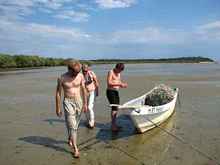 |
Local fishing boat. |
We made it! Two hours later, right on target we were so close
to Inhaca you could literally walk there! The rudder downhaul
popped out of its safety cleat every now and again, the way it
is suppose to function when not tied to tiller, and by this time
we had had enough of beating into the sea and the wind. A slow
meander up to camp in the lee of the island was what was called
for. The Seagull started on the third pull, as always, and the
sails where doused and put to bed. An hour later we came into
camp with the tide and the setting sun, having to push the boat
the last 500 meter or so. Something to do with "cold beer
fever" and a spring that prevents damage to the prop and
gearbox...
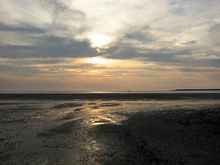 |
Kurkprop anchored in the distance. |
Luckily there was a whole party to help us; a search party! None
of the sms messages, detailing the change of plans, had got through.
But before you could read the Portuguese instruction on a Dois
M it turned into a real party and I never got to the bottom of
the missing sms story. The next morning we were up early. You
have to catch the tide or be left high and dry. With the cooler
bags packed, Mark lent us a small 2 HP Mariner but we opted for
a leisurely down-wind sail passed town for some supplies and then
on to snorkelling at the coral gardens. Now this is the average
weather I was talking about. Waiting on the beach for the “marauders”
to return with “loot”, we were approached by a police
officer wanting see all our papers. This is now your passport,
then your skipper’s ticket and then the navigational certificate
and, last but not least, the receipt for the island tax. He was
very friendly and efficient and just doing his job. Once again
I was impressed with Mozambique.
 |
Inhaca view |
For the first time in my life I saw real coral on this trip.
We found a sandy patch to drop anchor and let the rope out far
enough for us to drift to an interesting spot. Just looking over
the side of the boat you could see the fish swimming between the
most southerly coral in the world. The two sets of snorkelling
gear did the rounds and everybody got a chance to take a peek
at the wonder world down below. Some of us saw Nemo and some saw
puffer fish and then some of us had the privilege to be stung
by something we couldn't even see! A bit of salve from grandmother’s
first aid kit put it right. The idea of being something’s
left over jelly fish lunch had us heading straight to shore and
our own lunch! The rest of the afternoon was spent on our own
private beach, wading in the shallow warm water with only a beach-comber
or two and an old lady selling shells. She looked as though she
was part of the ocean and the land for a very long time as she
walked into the middle distance. Late afternoon had us motoring
back to camp. With the advice of "watch the prop" we
anchored a distance away and walked the last few hundred metres
back to camp, exploring the microcosms that make up life on the
sand flats as we went.
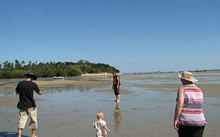 |
Taking the short cut to town. |
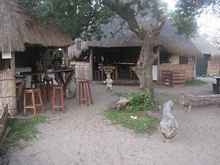 |
Manico camp |
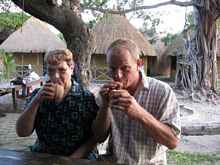 |
Mother and skipper sampling the Coco nut BoemBoems. |
|
Thrtee generations on the ferry. |
The next day we all suffered from too much sea, sand and surf,
so we opted to take it easy on the last day on the island. This
suited me perfectly. For the first time I could get Kurkprop ready
for the journey across the bay at a pace that suited me. The Seagull
was repaired with some stout wire and generous blobs of epoxy.
A composite repair. I just hope it lasts! The final round of shopping
was completed and we graciously accepted a bottle of the local
cinnamon rum as a parting gift. That evening we feasted on all
the left-over food and cinnamon rum. Nobody wanted an early start,
so we made it a good one, with lots of tales of adventures past,
present and future. We were up early the next morning anyway.
The toddlers and the idea of going home made sure of that! None
the worse for wear and after a good breakfast of pau, (the local
bread), bacon, eggs and coffee, we were all fit as a fiddle to
tackle the return journey.
 |
Feasti ng on the local cinnamon |
 |
Exploring the Low tide sand flats. |
It was a beautiful average day weather-wise, with a nice soft
warm breeze blowing and a long slow swell pushing us to Maputo.
That is, except for the 20% early evening thunder storms that
had been predicted, odds I decided I could take a chance on. With
the wind light and the need to dodge any thunder storm, it was
time to test our composite prop repair before we were too far
away from Inhaca. It was checked after one minute, then ten, and
then after thirty minutes once more. It looked and worked just
as planned, so we kept on heading in the direction of Maputo,
soaking up the sunshine. Everything was just as I had imagined
it would be when building Kurkprop on those long cold winter nights.
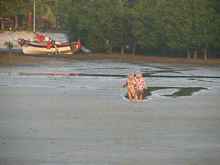 |
Drying out at low tide. |
Once again the weatherman got it almost right. I didn’t
need a degree to see that there was approximately an 80% chance
of afternoon thunder storms that day. By this time the wind had
freshened quite a bit, but the lightning visible behind Maputo
determined that our sails were kept firmly tied in place. It was
time to prepare for our first storm at sea. With everything secured,
the seagull filled up, the cool box ready to be deployed as a
makeshift drogue and the latest yellow and orange fashions donned,
we watched the spectacle as the storm front, back lit by the late
afternoon sun, chiselled its way from the mainland over Maputo
and out to sea. The last thing we did before we saw Maputo, from
five miles out, disappear completely behind the rain curtain was
to take a bearing with the hand compass, By this time the thunder
cell was sucking air in faster and faster. The swell had built
up considerably, with white caps all over the place. At least
we were being blown in the right direction, at least for the moment...
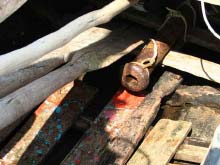 |
Dhow with a Canon. |
Within twenty minutes the wind had swung 180 degrees and we were
wondering what there was behind that fast-approaching curtain
that obliterated everything, but everything, from our view. It
was almost as bad as going to the dentist. However before we could
cancel the appointment, so to speak, we knew what was hiding behind
that curtain. Luckily the wind blew the sea flatter and flatter,
and every time I peeked up into the stinging rain and wind, the
sea looked like a large length of gray velvet with lovers lurking
underneath. Completely isolated from the rest of the world, we
huddled in rain coats, hiding from the rain and the wind. With
shouts of "Port; Port” and ”Starboard; Starboard"
the crew kept us heading in the right direction. Slowly the rain
and wind gave way and after I don't know how long we both looked
up, laughed, shook hands and hugged one another several times.
The worst was behind us! Half an hour later the ferry overtook
us a mile off the port beam, with lots of happy family waving
from the bow. Life is great when one is humbled by an experience
such as this. Suddenly one’s priorities are shuffled into
the right order and it is just good to be alive. With cheers and
cold beers we were welcomed back to the Maputo Marina. Congratulations
and hugs were handed out in large amounts by all. However, it
was my eldest daughter who had the foresight to walk over to Kurkprop
and pat her on the bow. If there is one person who needs congratulating,
it is John Welsford, the designer of the Houdini
Kurkprop, for his excellent work. Kurkprop spent
the night tied up to the jetty while we treated ourselves to a
feast of fresh Mozambique prawns and tales of new adventures.
(The Oscar Orchestra can start playing now. I am almost done!)
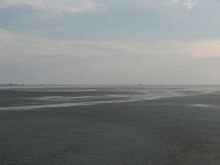 |
A dhow in the distance. |
The drive back home gave a lot of time for reflection. Would
I do it again? Yes! I am already planning for next year, but this
time it will be just me and one crew and two weeks to complete
a non-existent itinerary. Free to follow the wind! Will I sail
across Delagoa Bay again? Not if I can help it! This whole adventure
might sound a bit irresponsible, but one has to take some chances
in life. Kurkprop is chock-a-block full of permanent foam flotation.
We had all the safety equipment, and more, on board and the only
time we didn’t have visual contact with some sort of other
boat, was during the worst of the storm. I have sailed her extensively
in the past three years, capsized her and righted her again, solo.
Was I scared? Yes a little, but not as scared as I was sailing
on Sterkfontein Dam, solo. I am still working through that one.
It’s a story for another time...
Fair winds
Herco

***** |

